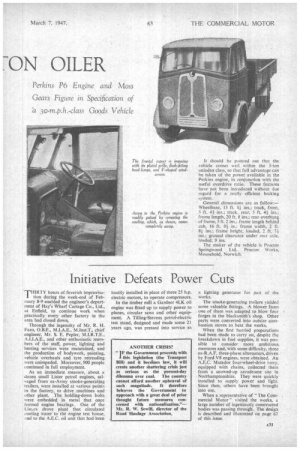Initiative Defeats Power Cuts
Page 33

If you've noticed an error in this article please click here to report it so we can fix it.
TE-IIRTY hours of feverish improvisation during the week-end of February 8-9 enabled the engineer's department of Hay's Wharf Cartage Co., Ltd., at Enfield, to continue work when practically every other factory in the area had closed down.
Through the ingenuity of Mr. R. H. Faro, O.R.E., M.I.A.E., Minst.T., chief engineer, Mr. S. E. Pepler, M.1.R.T.E., A.I.I.A.E., and other enthusiastic members of the staff, power, lighting and heating services were maintained, and the production of bodywork, painting, vehicle overhauls and tyre retreading were unimpeded. Moreover, 900 people continued in full employment.
As an immediate measure, about a dozen small Lister petrol engines, salvaged from ex-Army smoke-generating trailers, were installed at various points in the factory, to drive machines and other plant The holding-down bolts were embedded in metal that once formed engine bearings. One of the Livers drove plant that circulated cooling water to the engine test house, ind to the A.E.C. oil unit that had been hastily installed in place of three 25 h.p. electric motors, to operate compressors.
In the timber mill a Gardner 4LK oil engine was fitted up to supply power to planes, circular saws and other equipment. A Tilling-Stevens petrol-electric lest stand, designed and made some 21 Years ago, was pressed into service as a lighting generator for part of the works.
The smoke-generating trailers yielded some valuable fittings. A blower from one of them was adapted to blow four forges in the blacksmith's shop. Other parts were converted into outsize combustion stoves to heat the works.
When the first hurried preparations had been made to carry on, despite the breakdown in fuel supplies, it was possible to consider more ambitious measures and, with some difficulty, three ex-R.A.F. three-phase alternators, driven by Ford V8 engines, were obtained. An A.E.C. Matador four-wheel-drive lorry, equipped with chains, collected them from a snowed-up aerodrome site in Northamptonshire. They were quickly installed to supply power and light. Since then, others have been brought into use.
When a representative of '' The Commercial Motor" visited the works, a large number of ingeniously constructed bodies was passing through. The design is described and illustrated on page 67 of this issue.












































































